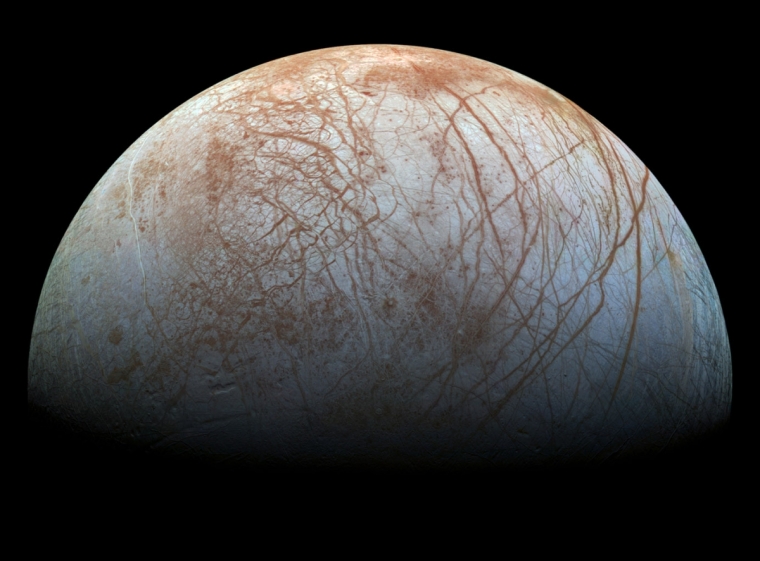Life In Jupiter's Moon? Scientists Believe It's Highly Possible

Now more than ever, scientists believe that we are not alone, that some other worlds exist that have the right mix of elements to sustain life as we know it.
And now, they're looking at a celestial body not very far from Earth -- in fact right within our own solar system -- where there is a "high degree of confidence" of such a living world.
NASA has just released a "remastered" or enhanced high-res color image of Europa, one of Jupiter's four large moons. The photo shown above is the reprocessed image originally taken by the Galileo spacecraft which explored Jupiter and its moons from orbit in the 1990s.
The photo, released by NASA on Nov. 21, shows Europa's amazing colors as they have never been seen before.
Backed by the image, NASA made the startling announcement that they have found "the most promising place in our solar system beyond Earth to look for present-day environments that are suitable for life."
"The Galileo mission found strong evidence that a subsurface ocean of salty water is in contact with a rocky seafloor. The cycling of material between the ocean and ice shell could potentially provide sources of chemical energy that could sustain simple life forms," NASA officials said in a statement.
"For the first time in the history of humanity we have the tools and technology and capability to potentially answer this question (of the existence of life beyond Earth), and we know where to go to find it -- Jupiter's ocean world, Europa," said Kevin Hand, an astrobiologist with NASA's Jet Propulsion Laboratory.
Last February, suspicions that Europa is not frozen solid were bolstered when scientists observed vapor plumes coming from its surface as seen from the images sent by the Hubble space telescope.
With a 3,120 km diameter, Europa is a bit smaller than our own Moon. But unlike our Moon, which is made of pure rock, Europa has a rocky core covered with liquid salty water beneath a shell of ice measuring about 100 km, scientists say. In fact, according to NASA, Europa may have more liquid water than Earth.
But how can Europa have liquid ocean when it is so far away from the sun?
NASA scientists explained that the immense gravity of Jupiter, not the sun, is the one responsible for Europa's liquid ocean. As the moon orbits the giant gas planet, Jupiter's immense gravity causes Europa to contract or flex, with the resulting heat and energy allowing water to remain liquid, scientists said. The flexing movement in Europa smashes its water against rocks that can yield amino acids and other potential building blocks of life, they added.
The evidence of this is found in the image. Scientists say the cracks on the moon's surface are where ice floes fit together. The brighter areas are nearly pure water ice, but the red/orange regions are cracks, possibly where briny water has been squeezed to the surface, NASA scientists said.
NASA intends to explore Europa with its proposed missions to Jupiter's icy moon in 2025.
Aside from Europa, NASA is also looking at other places in our own solar system where liquid water is possible to exist. For instance, the Cassini spacecraft recently uncovered evidence of a possible ocean under the surface of Saturn's moon, Mimas. The Cassini spacecraft has also observed geysers spewing on Saturn's moon, Enceladus.
 Christians don't have to affirm transgenderism, but they can’t express that view at work: tribunal
Christians don't have to affirm transgenderism, but they can’t express that view at work: tribunal Archaeology discovery: Medieval Christian prayer beads found on Holy Island
Archaeology discovery: Medieval Christian prayer beads found on Holy Island Presbyterian Church in America votes to leave National Association of Evangelicals
Presbyterian Church in America votes to leave National Association of Evangelicals Over 50 killed in 'vile and satanic' attack at Nigerian church on Pentecost Sunday
Over 50 killed in 'vile and satanic' attack at Nigerian church on Pentecost Sunday Ukrainian Orthodox Church severs ties with Moscow over Patriarch Kirill's support for Putin's war
Ukrainian Orthodox Church severs ties with Moscow over Patriarch Kirill's support for Putin's war Islamic State kills 20 Nigerian Christians as revenge for US airstrike
Islamic State kills 20 Nigerian Christians as revenge for US airstrike Man who served 33 years in prison for murder leads inmates to Christ
Man who served 33 years in prison for murder leads inmates to Christ


 Nigerian student beaten to death, body burned over ‘blasphemous’ WhatsApp message
Nigerian student beaten to death, body burned over ‘blasphemous’ WhatsApp message 'A new low': World reacts after Hong Kong arrests 90-year-old Cardinal Joseph Zen
'A new low': World reacts after Hong Kong arrests 90-year-old Cardinal Joseph Zen Iran sentences Christian man to 10 years in prison for hosting house church worship gathering
Iran sentences Christian man to 10 years in prison for hosting house church worship gathering French Guyana: Pastor shot dead, church set on fire after meeting delegation of Evangelicals
French Guyana: Pastor shot dead, church set on fire after meeting delegation of Evangelicals ‘Talking Jesus’ report finds only 6% of UK adults identify as practicing Christians
‘Talking Jesus’ report finds only 6% of UK adults identify as practicing Christians Mission Eurasia ministry center blown up in Ukraine, hundreds of Bibles destroyed: 'God will provide'
Mission Eurasia ministry center blown up in Ukraine, hundreds of Bibles destroyed: 'God will provide' Church holds service for first time after ISIS desecrated it 8 years ago
Church holds service for first time after ISIS desecrated it 8 years ago Burger King apologizes for 'offensive campaign' using Jesus' words at the Last Supper
Burger King apologizes for 'offensive campaign' using Jesus' words at the Last Supper Uganda: Muslims abduct teacher, burn him inside mosque for praying in Christ’s name
Uganda: Muslims abduct teacher, burn him inside mosque for praying in Christ’s name